大学热分析动力学 Thermal Analysis Kinetics
- 格式:ppt
- 大小:832.00 KB
- 文档页数:85
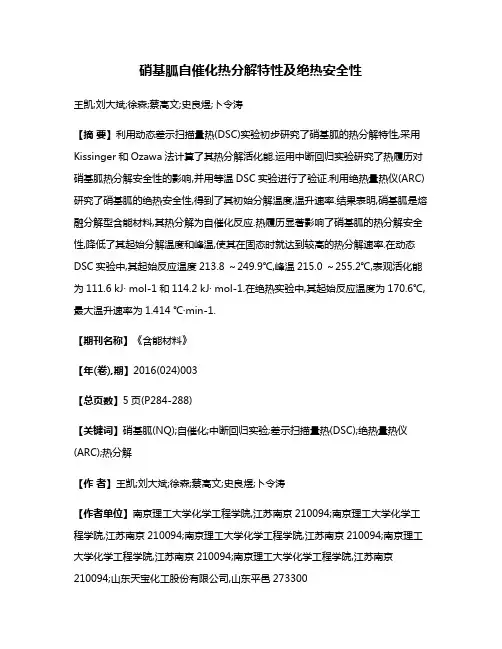
硝基胍自催化热分解特性及绝热安全性王凯;刘大斌;徐森;蔡高文;史良煜;卜令涛【摘要】利用动态差示扫描量热(DSC)实验初步研究了硝基胍的热分解特性,采用Kissinger和Ozawa法计算了其热分解活化能.运用中断回归实验研究了热履历对硝基胍热分解安全性的影响,并用等温DSC实验进行了验证.利用绝热量热仪(ARC)研究了硝基胍的绝热安全性,得到了其初始分解温度,温升速率.结果表明,硝基胍是熔融分解型含能材料,其热分解为自催化反应.热履历显著影响了硝基胍的热分解安全性,降低了其起始分解温度和峰温,使其在固态时就达到较高的热分解速率.在动态DSC实验中,其起始反应温度213.8 ~249.9℃,峰温215.0 ~255.2℃,表观活化能为111.6 kJ· mol-1和114.2 kJ· mol-1.在绝热实验中,其起始反应温度为170.6℃,最大温升速率为1.414 ℃·min-1.【期刊名称】《含能材料》【年(卷),期】2016(024)003【总页数】5页(P284-288)【关键词】硝基胍(NQ);自催化;中断回归实验;差示扫描量热(DSC);绝热量热仪(ARC);热分解【作者】王凯;刘大斌;徐森;蔡高文;史良煜;卜令涛【作者单位】南京理工大学化学工程学院,江苏南京210094;南京理工大学化学工程学院,江苏南京210094;南京理工大学化学工程学院,江苏南京210094;南京理工大学化学工程学院,江苏南京210094;南京理工大学化学工程学院,江苏南京210094;山东天宝化工股份有限公司,山东平邑273300【正文语种】中文【中图分类】TJ55;O651 引言硝基胍(NQ)是一种常用的、重要的火炸药[1],爆炸威力略高于TNT(104%TNT当量),具有爆温低(约2400 K)、感度低(摩擦感度、撞击感度均为0)、原材料便宜易得、生产工艺简单等优点。
硝基胍制得的火药能量较高而烧蚀较低,炮口焰炮尾焰较少,温度系数也较低,是一种良好的火药原料[2-4]。


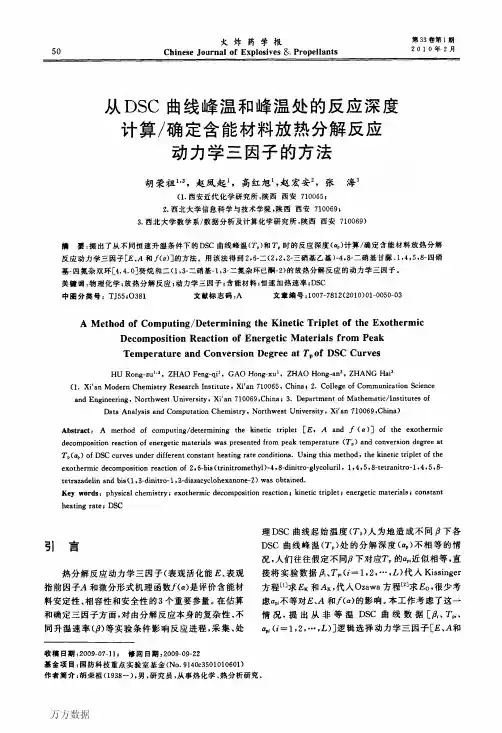
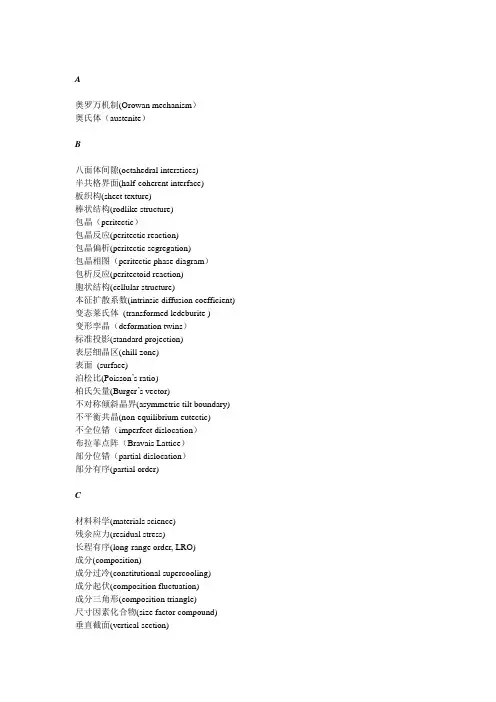
A奥罗万机制(Orowan mechanism)奥氏体(austenite)B八面体间隙(octahedral interstices)半共格界面(half-coherent interface)板织构(sheet texture)棒状结构(rodlike structure)包晶(peritectic)包晶反应(peritectic reaction)包晶偏析(peritectic segregation)包晶相图(peritectic phase diagram)包析反应(peritectoid reaction)胞状结构(cellular structure)本征扩散系数(intrinsic diffusion coefficient) 变态莱氏体(transformed ledeburite )变形孪晶(deformation twins)标准投影(standard projection)表层细晶区(chill zone)表面(surface)泊松比(Poisson’s ratio)柏氏矢量(Burger’s vector)不对称倾斜晶界(asymmetric tilt boundary) 不平衡共晶(non-equilibrium eutectic)不全位错(imperfect dislocation)布拉菲点阵(Bravais Lattice)部分位错(partial dislocation)部分有序(partial order)C材料科学(materials science)残余应力(residual stress)长程有序(long-range order, LRO)成分(composition)成分过冷(constitutional supercooling)成分起伏(composition fluctuation)成分三角形(composition triangle)尺寸因素化合物(size factor compound)垂直截面(vertical section)纯铁(pure iron)脆性(brittleness)D大角度晶界(high-angle grain boundary)单晶体(single crystal)单位位错(unit dislocation)单相(single phase)单相合金(homogeneous alloy)单斜晶系(monoclinic crystal system)倒易点阵(reciprocal lattice)等温线投影图(polythermal projection)等腰成分三角形(isosceles composition triangle)等轴晶区(equiaxed zone)点缺陷(point defects)点阵常数(lattice constant)点阵畸变(lattice distortion)电负性(electronegativity)电离能(ionization energy of atoms)电子化合物(electron compound, Hume-Rothery phase)电子浓度(electron concentration)电子亲和能(affinity energy of electrons)动力学(kinetics)动态过冷(dynamic supercooling)动态回复(dynamic recovery)动态再结晶(dynamic recrystallization)短程有序(short-range order, SRO)短路扩散(short circuit diffusion)堆垛层错(stacking fault)堆垛层错能(stacking fault energy)对称倾斜晶界(symmetric tilt boundary)多边化(polygonization)多滑移(multiple slip)多晶体(polycrystalline solid)多晶型性(polymorphism)多相材料(polyphase materials, heterogeneous)多相合金(heterogeneous alloy)E二次键(secondary bonding)二次再结晶(secondary recrystallization)二维晶核机制(two-dimensional nucleation)二元相图(binary phase diagrams )F反应扩散(reaction diffusion)范德瓦耳斯键(van der Waals bonding)非共格界面(non-coherent interface)非共格孪晶界(non-coherent twin boundary)非晶体(amorphous material)非均匀形核(heterogeneous nucleation)非平衡凝固(nonequilibrium solidification)非稳态扩散(nonsteady-state diffusion)菲克第二定律(Fick’s second law)菲克第一定律(Fick’s first law)分切应力(resolved shear stress)弗兰克尔缺陷(Frenkel defects)弗兰克-瑞德源(Frank-Read source)复合材料(composite)复合晶胞(composite unit cell)G杠杆定律(lever rule)高斯解(Guass solution)Gibbs相律(Gibbs phase rule)公切线法则(common tangent line)共轭连线(conjugate lines)共轭曲线(conjugate curves)共格孪晶界(coherent twin boundary)共格相界(coherent phase interface)共价键(covalent bonding)共晶(eutectic)共晶白口铸铁(eutectic white cast iron)共晶反应(eutectic reaction):共晶合金(eutectic alloy)共晶相图(eutectic phase diagram)共析反应(eutectoid reaction)共析钢(eutectoid steel)固溶强化(solid-solution strengthening)固溶体(solid solution)固相线(solidus)过饱和点缺陷(supersaturated point defects)过共晶白口铸铁(hyper-eutectic white cast iron) 过共晶合金(hypereutectic alloy)过共析钢(hyper-eutectoid steel)过冷(supercooling)过冷度(the degree of supercooling)H合金(alloy)合晶反应(synthetic reaction)合力(net force)宏观结构(macrostructure)虎克定律(Hooke’s law)互扩散(interdiffusion)互扩散系数(interdiffusion coefficient)滑移(slip)滑移带(slip bands)滑移系(slip systems)滑移线(slip lines)化合物(intermediate compound)化学亲和力(chemical affinity)环形换位(cyclic exchange)回复(recovery)混合位错(mixed dislocation)霍尔—佩奇公式(Hall-Petch equation)J极射投影(stereographic project)激活能(activation energy)加工硬化(work hardening, strain hardening) 间隙(interstices)间隙固溶体(interstitial solid solution)间隙化合物(interstitial compound)间隙相(interstitial phase)简单晶胞(simple unit cell)交滑移(cross slip)结构起伏(structure fluctuation)结合键(bonding)结合能(bonding energy)结晶(crystallization)介稳相(metastable phase)金属(metal)金属间化合物(intermetallic compound)金属键(metallic bonding)晶胞(unit cells)晶带(crystal zone)晶带轴(crystal zone axis)晶格(crystal lattice)晶核(nucleus of crystal)晶界(grain boundary)晶界能(boundary energy)晶粒长大(grain growth)晶面(crystal planes)晶面间距(inter-planer spacing)晶面指数(Miller indices of crystallographic plane)晶面转动(rotation of crystal plane)晶面族(a family of crystal planes)晶胚(crystal embryo)晶体(crystalline solid)晶体结构(crystal structures)晶系(crystal system)晶向(crystal directions)晶向指数(Orientation index, Miller indices for the direction) 晶向族(a family of crystal directions)晶轴(crystal axes)均匀形核(homogeneous nucleation)K抗拉强度σb (tensile strength)柯肯达尔效应(Kirkendall effect)柯氏气团(Cottrell atmosphere)空间点阵(space lattice)空位(vacancy)空位机制( vacancy mechanism)扩散(diffusion)扩散常数(diffusion constant)扩散方程(diffusion equation)扩散机制(diffusion mechanism)扩散通量(diffusion flux)扩散系数(diffusion coefficient)扩散系数(diffusion coefficient)扩展位错(extended dislocation)L拉弗斯相(Laves phase)莱氏体(Ld, ledeburite)冷却曲线(cooling curve)冷作硬化(cold working)离子键(ionic bonding)离子晶体(ionic crystal)立方晶系(cubic crystal system)连续生长(continuous growth)临界半径(critical radius)临界变形度(critical degree of deformation)临界分切应力(critical resolved shear stress)临界晶核(critical nucleus)菱方晶系(rhombohedral crystal system)六方晶系(hexagonal crystal system)吕德斯带(Lüders band)孪晶(twins)孪晶界(twin boundary)孪生(twinning)螺型位错(screw dislocation)M弥散粒子(precipitate)密排堆垛结构(close packed crystal structures)密排六方结构(hexagonal close-packed crystal structure,HCP,A3)面角位错(Lomer-Cottrell dislocation)面缺陷(planar defects)面心立方结构(face-centered cubic crystal structure,FCC,A1)N纳米结构(nanostructure)能量起伏(energy fluctuation)凝固(Solidification)扭折(kink)扭转晶界(twist boundary)浓度(concentration)浓度梯度(concentration gradient)P排斥力(repulsive force)派—纳力(Peierls-Nabarro force,P-N force)攀移(climb)配位数(CN, coordination number)偏晶反应(monotectic reaction)偏聚(solute cluster)片状结构(lamellar structure)平衡分配系数(equilibrium partition coefficient)平衡凝固(equilibrium solidification)平衡状态图(equilibrium or constitutional diagram)。
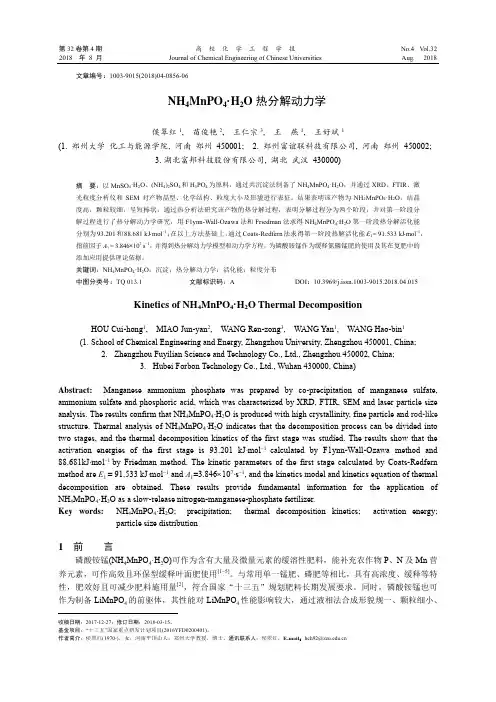
第32卷第4期高校化学工程学报No.4 V ol.32 2018 年 8 月 Journal of Chemical Engineering of Chinese Universities Aug. 2018文章编号:1003-9015(2018)04-0856-06NH4MnPO4·H2O热分解动力学侯翠红1, 苗俊艳2, 王仁宗3, 王燕1, 王好斌1(1. 郑州大学化工与能源学院, 河南郑州 450001; 2. 郑州富谊联科技有限公司, 河南郑州 450002;3.湖北富邦科技股份有限公司, 湖北武汉 430000)摘要:以MnSO4·H2O、(NH4)2SO4和H3PO4为原料,通过共沉淀法制备了NH4MnPO4·H2O,并通过XRD、FTIR、激光粒度分析仪和SEM对产物晶型、化学结构、粒度大小及形貌进行表征。
结果表明该产物为NH4MnPO4·H2O,结晶度高,颗粒较细,呈短棒状。
通过热分析法研究该产物的热分解过程,表明分解过程分为两个阶段,并对第一阶段分解过程进行了热分解动力学研究,用F1ynn-Wall-Ozawa法和Friedman法求得NH4MnPO4·H2O第一阶段热分解活化能分别为93.201和88.681 kJ⋅mol-1;在以上方法基础上,通过Coats-Redfern法求得第一阶段热解活化能E1= 91.533 kJ⋅mol-1,指前因子A1 = 3.846⨯107 s-1,并得到热分解动力学模型和动力学方程,为磷酸铵锰作为缓释氮磷锰肥的使用及其在复肥中的添加应用提供理论依据。
关键词:NH4MnPO4·H2O;沉淀;热分解动力学;活化能;粒度分布中图分类号:TQ 013.1 文献标识码:A DOI:10.3969/j.issn.1003-9015.2018.04.015Kinetics of NH4MnPO4·H2O Thermal DecompositionHOU Cui-hong1, MIAO Jun-yan2, WANG Ren-zong3, WANG Yan1, WANG Hao-bin1(1. School of Chemical Engineering and Energy, Zhengzhou University, Zhengzhou 450001, China;2.Zhengzhou Fuyilian Science and Technology Co., Ltd., Zhengzhou 450002, China;3.Hubei Forbon Technology Co., Ltd., Wuhan 430000, China)Abstract: Manganese ammonium phosphate was prepared by co-precipitation of manganese sulfate, ammonium sulfate and phosphoric acid, which was characterized by XRD, FTIR, SEM and laser particle size analysis. The results confirm that NH4MnPO4⋅H2O is produced with high crystallinity, fine particle and rod-like structure. Thermal analysis of NH4MnPO4⋅H2O indicates that the decomposition process can be divided into two stages, and the thermal decomposition kinetics of the first stage was studied. The results show that the activation energies of the first stage is 93.201 kJ⋅mol-1 calculated by F1ynn-Wall-Ozawa method and 88.681kJ⋅mol-1 by Friedman method. The kinetic parameters of the first stage calculated by Coats-Redfern method are E1= 91.533 kJ⋅mol-1 and A1=3.846⨯107⋅s-1, and the kinetics model and kinetics equation of thermal decomposition are obtained. These results provide fundamental information for the application of NH4MnPO4·H2O as a slow-release nitrogen-manganese-phosphate fertilizer.Key words: NH4MnPO4·H2O;precipitation; thermal decomposition kinetics; activation energy;particle size distribution1前言磷酸铵锰(NH4MnPO4·H2O)可作为含有大量及微量元素的缓溶性肥料,能补充农作物P、N及Mn营养元素,可作高效且环保型缓释叶面肥使用[1~5]。

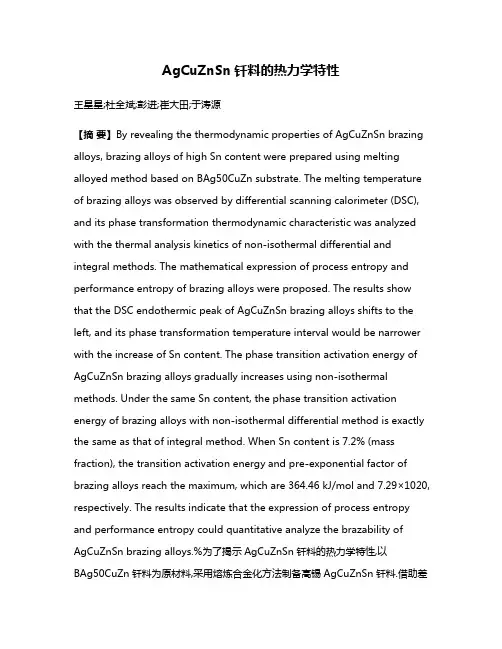
AgCuZnSn钎料的热力学特性王星星;杜全斌;彭进;崔大田;于涛源【摘要】By revealing the thermodynamic properties of AgCuZnSn brazing alloys, brazing alloys of high Sn content were prepared using melting alloyed method based on BAg50CuZn substrate. The melting temperature of brazing alloys was observed by differential scanning calorimeter (DSC), and its phase transformation thermodynamic characteristic was analyzed with the thermal analysis kinetics of non-isothermal differential and integral methods. The mathematical expression of process entropy and performance entropy of brazing alloys were proposed. The results show that the DSC endothermic peak of AgCuZnSn brazing alloys shifts to the left, and its phase transformation temperature interval would be narrower with the increase of Sn content. The phase transition activation energy of AgCuZnSn brazing alloys gradually increases using non-isothermal methods. Under the same Sn content, the phase transition activation energy of brazing alloys with non-isothermal differential method is exactly the same as that of integral method. When Sn content is 7.2% (mass fraction), the transition activation energy and pre-exponential factor of brazing alloys reach the maximum, which are 364.46 kJ/mol and 7.29×1020, respectively. The results indicate that the expression of process entropy and performance entropy could quantitative analyze the brazability of AgCuZnSn brazing alloys.%为了揭示AgCuZnSn钎料的热力学特性,以BAg50CuZn钎料为原材料,采用熔炼合金化方法制备高锡AgCuZnSn钎料.借助差示扫描量热仪(DSC)测定不同Sn含量AgCuZnSn钎料的熔化温度,运用热分析动力学中的非等温微分法和积分法分析AgCuZnSn钎料的相变热力学特性.利用热力学熵的概念,提出AgCuZnSn钎料钎焊工艺熵和接头性能熵的数学表达式.结果表明:随着Sn含量升高,AgCuZnSn钎料的吸热峰向左偏移,且在吸热峰钎料相变温度区间变窄.非等温微分法和积分法得到的AgCuZnSn钎料的相变活化能随着Sn含量增加逐渐增大;当Sn含量相同时,两种方法得到的钎料相变活化能几乎相同.当Sn 含量为7.2%(质量分数)时,AgCuZnSn钎料的相变活化能和指前因子值最大,分别为364.46 kJ/mol和7.29×1020.试验结果证实了钎焊工艺熵和接头性能熵的表达式在一定程度上可定量表征AgCuZnSn钎料的钎焊性能.【期刊名称】《中国有色金属学报》【年(卷),期】2018(028)006【总页数】9页(P1159-1167)【关键词】银钎料;熔化特性;热力学熵;活化能【作者】王星星;杜全斌;彭进;崔大田;于涛源【作者单位】华北水利水电大学机械学院,郑州450045;华北水利水电大学机械学院,郑州450045;华北水利水电大学机械学院,郑州450045;华北水利水电大学机械学院,郑州450045;华北水利水电大学机械学院,郑州450045【正文语种】中文【中图分类】TG454钎料作为钎焊时的填充材料,其性能在很大程度上决定钎焊接头的质量和性能。
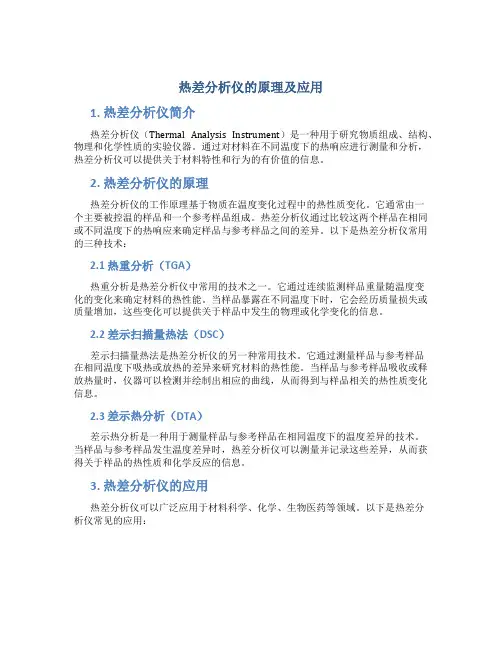
热差分析仪的原理及应用1. 热差分析仪简介热差分析仪(Thermal Analysis Instrument)是一种用于研究物质组成、结构、物理和化学性质的实验仪器。
通过对材料在不同温度下的热响应进行测量和分析,热差分析仪可以提供关于材料特性和行为的有价值的信息。
2. 热差分析仪的原理热差分析仪的工作原理基于物质在温度变化过程中的热性质变化。
它通常由一个主要被控温的样品和一个参考样品组成。
热差分析仪通过比较这两个样品在相同或不同温度下的热响应来确定样品与参考样品之间的差异。
以下是热差分析仪常用的三种技术:2.1 热重分析(TGA)热重分析是热差分析仪中常用的技术之一。
它通过连续监测样品重量随温度变化的变化来确定材料的热性能。
当样品暴露在不同温度下时,它会经历质量损失或质量增加,这些变化可以提供关于样品中发生的物理或化学变化的信息。
2.2 差示扫描量热法(DSC)差示扫描量热法是热差分析仪的另一种常用技术。
它通过测量样品与参考样品在相同温度下吸热或放热的差异来研究材料的热性能。
当样品与参考样品吸收或释放热量时,仪器可以检测并绘制出相应的曲线,从而得到与样品相关的热性质变化信息。
2.3 差示热分析(DTA)差示热分析是一种用于测量样品与参考样品在相同温度下的温度差异的技术。
当样品与参考样品发生温度差异时,热差分析仪可以测量并记录这些差异,从而获得关于样品的热性质和化学反应的信息。
3. 热差分析仪的应用热差分析仪可以广泛应用于材料科学、化学、生物医药等领域。
以下是热差分析仪常见的应用:3.1 研究材料的热性质热差分析仪可以用来研究材料的热导率、比热容、热膨胀系数等热性质。
通过测量材料在不同温度下的热响应,可以获得关于材料性能的宝贵信息,为材料的开发和改进提供科学依据。
3.2 分析材料的稳定性和降解行为热差分析仪可以用来研究材料的稳定性和降解行为。
通过对材料在升温或降温过程中的热响应进行监测,可以确定材料的热分解温度、热稳定性以及其它热性质的变化,为材料的使用和储存提供重要参考。

火灾学课程热分析动力学(Thermal Analysis Kinetics)定义¾热分析动力学:用热分析技术研究某种物理变化或化学反应(以下统称反应)的动力学热分析技术的定量化方法热分析动力学的目的 理论上:探讨物理变化或化学反应的机理(尤其是非均相、不等温)生产上:提供反应器设计参数应用上:建立过程进度、时间和温度之间的关系,可用于预测材料的使用寿命和产品的保质稳定期,评估含能材料的危险性,从而提供储存条件。
可估计造成环境污染物质的分解情况…发展历史化学动力学源于19世纪末-20世纪初热分析动力学始于20世纪30年代、盛于50年代(评估高分子材料在航空航天应用中的稳定性和使用寿命研究的需要))动力学模式(机理)函数均相反应: f ( c)= ( 1 -c)n非均相反应:根据控制反应速率的“瓶颈”气体扩散相界面反应成核和生长常见固态反应的机理函数(理想化)1. Acceleratory(The shape of a ~T curve) Symbol f(a)g(a)n(α)1-1/n α 1/nPnα lnαE12. Sigmoidm(1−α)[−ln(1−α)]1−1/m[-ln(1-a)]1/m Amα(1−α) ln[α/(1−α)] B1(1/2)(1−α)[−ln(1−α)]−1 [−ln(1−α)]2 B2(1/3)(1−α)[−ln(1−α)]−2[−ln(1−α)]3 B3(1/4)(1−α)[−ln(1−α)]−3 [−ln(1−α)]4 B43. Deceleratory2(1−α)1/21−(1−α)1/2R23(1−α)2/31−(1−α)1/3R31/2α α2D1[−ln(1−α)]−1(1−α)ln(1−α)+α D2D(3/2)(1−α)2/3[1−(1−α)2/3]−1[1−(1−α)1/3]2 3(3/2)[(1−α)−1/3−1]−11−2α/3−(1−α)2/3 D4D(−3/2)(1−α)2/3[(1−α)1/3−1]−1[(1−α)1/3−1]2 5D(3/2)(1−α)4/3[(1−α)−1/3−1]−1 [(1−α)−1/3−1]2 6F* 1−α −1n(1−α) 1(1-α) 21/(1-α) F2(1-α) 3/2(1/1−α) 2 F32(1−α) 3/2(1−α) −1/2 F(3/2)(2/3)(1−α) 5/2(1−α) −3/2 F(5/2)*F1 is the same as A1Sestak-Berggren empirical function(1971)f (α ) = αm (1−α) n2. 热分析动力学方法按动力学方程形式:微商法积分法按加热速率方式:单个扫描速率法(single scanning method)多重扫描速率法(multiple scanning method) (等转化率法,iso-conversional)Kissinger-Akahira-Sunose equationAnal. Chem., 29(1957)1702作多重加热速率β下的测定,选择TA 曲线峰值对应的温度T p由线性方程斜率——E ,然后由截矩——A 注:1. Kissinger(1956): 在最大速率处,适于n 级反应2.Akahira-Sunose(1969): 指定α处亦可3. Ozawa: 不限于n 级反应ppRT E E AR T /)/ln()/ln(2−=β非等温实验:特征点法举例:CaCO3热解动力学分析Friedman equation (modelfree )J. Polym. Sci. Part C, 6(1964)183作多重加热速率β下的测定,选择等α处斜率——E ;截矩——若则:斜率——E ; 截矩——ART E Af dT d /)](ln[)]/(ln[−=ααβnf )1()(αα−=)1ln(ln )](ln[αα−+=n A Af )](ln[αAf温度积分的近似表达式¾Doyle 近似式(J. Appl. Polym. Sci.,6(1962)639 )¾Schlomlich 展开级数(Doyle , Nature, 207(1965)290 )¾经验公式(Zsaco , J. Thermal Anal. 8(1975)593))1()1()3)(2(2211[)1()(−+⋅⋅⋅−+⋅⋅⋅−++++−+=−n x n x x x x x e x p n x )2)(/()(−−≈−x d x e x p x )844/(162+−=x x d xx p 4567.0315.2)(lg −−≈)6020(≤≤x2u u 2222(1)(1)u E RT e ART RT e u u EE β−−−=−2[1]}RT E E RT −−ADN的不等温热分解反应动力学参数模式 E / kJ mol-1lnA/ min-1γP4 24.5 3.9 0.9783 P3 35.1 6.9 0.9813 P2 56.2 12.7 0.9837 P2/3 182.9 46.2 0.9862 D1 246.2 62.8 0.9865 F1 139.4 35.70.9928 A4 29.5 5.3 0.9903 A3 41.7 9.0 0.9913 A2 66.1 15.9 0.9921 D3 269.1 67.4 0.9928 R3 131.0 32.0 0.9924 R2 127.6 31.3 0.9910Flynn-Wall-Ozawa equation (model free )Bull. Chem. Soc. Jpn.,38(1965)1881取不同β下曲线的等α处之温度T作lg β~1/T 图,由斜率——E注:Ozawa (1965): 在最大转化速率处Flynn-Wall (1966): 指定α处亦可RT E Rg AE /4567.0315.2)(lg lg −−=αβ参考书籍胡荣祖等. 《热分析动力学》(第二版) . 北京科学出版社, 2008.。
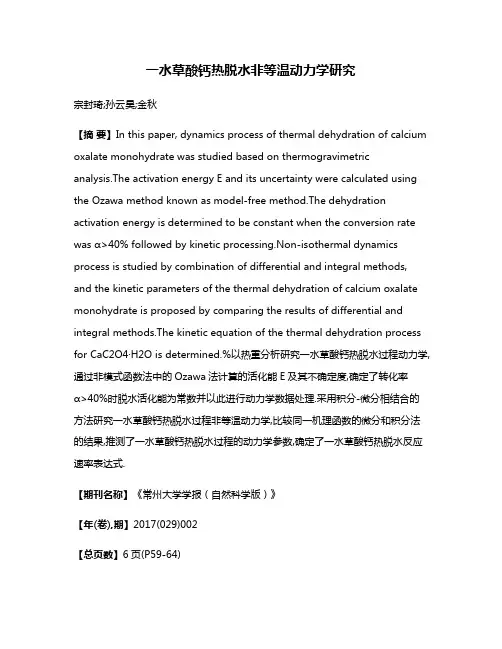
一水草酸钙热脱水非等温动力学研究宗封琦;孙云昊;金秋【摘要】In this paper, dynamics process of thermal dehydration of calcium oxalate monohydrate was studied based on thermogravimetric analysis.The activation energy E and its uncertainty were calculated using the Ozawa method known as model-free method.The dehydration activation energy is determined to be constant when the conversion rate was α>40% followed by kinetic processing.Non-isothermal dynamics process is studied by combination of differential and integral methods, and the kinetic parameters of the thermal dehydration of calcium oxalate monohydrate is proposed by comparing the results of differential and integral methods.The kinetic equation of the thermal dehydration process for CaC2O4·H2O is determined.%以热重分析研究一水草酸钙热脱水过程动力学,通过非模式函数法中的Ozawa法计算的活化能E及其不确定度,确定了转化率α>40%时脱水活化能为常数并以此进行动力学数据处理.采用积分-微分相结合的方法研究一水草酸钙热脱水过程非等温动力学,比较同一机理函数的微分和积分法的结果,推测了一水草酸钙热脱水过程的动力学参数,确定了一水草酸钙热脱水反应速率表达式.【期刊名称】《常州大学学报(自然科学版)》【年(卷),期】2017(029)002【总页数】6页(P59-64)【关键词】非等温动力学;一水草酸钙;反应机理函数【作者】宗封琦;孙云昊;金秋【作者单位】常州大学石油化工学院,江苏常州 213164;常州大学石油化工学院,江苏常州 213164;常州大学石油化工学院,江苏常州 213164【正文语种】中文【中图分类】O0657热分析动力学[1-2] (Thermal analysis kinetics)是用热分析技术研究物质的物理变化和化学反应的动力学参数和反应机理的方法。
马贺等:水热合成β-MnO2纳米棒的电磁特性· 1201 ·第36卷第7期电石渣与石灰石热分解特性比较及电石渣热分解动力学闫羽1,李福洲1,陶从喜2(1. 武汉理工大学材料科学与工程学院,武汉 430070;2. 天津水泥工业设计研究院有限公司,天津 300400)摘要:用热分析曲线比较电石渣和石灰石分解特性。
通过热分析得到电石渣中氢氧化钙和石灰石中碳酸钙分解热耗分别为72.253kJ/mol和142.933 kJ/mol;热力学计算氢氧化钙和碳酸钙理论分解热耗分别为101.625kJ/mol和166.232kJ/mol,热分析结果比热力学计算值低。
采用Melak法求得电石渣中氢氧化钙分解的活化能E a=124.01kJ/mol,反应机理函数微分形式为f (a) = (1–a)2/3 (其中a为相应物质转化率),动力学因子为20.92。
关键词:电石渣;分解热耗;分解动力学;活化能;反应机理;动力学因子中图分类号:TB321 文献标志码:A 文章编号:0454–5648(2009)07–1201–05COMPARISON OF THERMAL DECOMPOSITION CHARACTERISTICS OF CARBIDE SLUDGE AND LIMESTONE AND THERMAL DECOMPOSITION KINETICS OF CARBIDE SLUDGEYAN Yu1,LI Fuzhou1,TAO Congxi2(1. The College of Materials Science and Engineering, Wuhan University of Technology, Wuhan 430070; 2. Tianjin CementIndustry Design & Research Institute Co., Tianjin 300400, China)Abstract: The carbide sludge and limestone heat decomposition characteristics are compared and the thermal decomposition process is illustrated by the measured thermal decomposition curves. The heat of decomposition of Ca(OH)2 in carbide sludge is 72.253 kJ/mol and the decomposition of CaCO3 in limestone is 142.933kJ/mol, and which are lower than the thermodynamic calculation data which the heat of decomposition of Ca(OH)2 is 101.625kJ/mol and the decomposition of CaCO3 is 166.232kJ/mol. The activity en-ergy of the thermal decomposition of Ca(OH)2 in carbide sludge is 124.01kJ/mol, the reaction function is f (a) = (1–a)2/3 and the pre-exponential factor is 20.92, which are deduced using the Melak method.Key words: carbide sludge; heat of decomposition; thermal decomposition kinetics; activation energy; reaction order; pre-exponential factor电石渣是化工厂利用电石水解生产乙炔气后排出的以氢氧化钙为主要成分的工业废渣,[1]用其代替石灰石生产水泥是目前电石渣综合利用中比较彻底的方法。
热重分析法研究氢氧化镁纳米粉体的非等温分解动力学李歌;李增和;马鸿文;陈登利【摘要】Hexagonal nano-magnesium hydroxide with thickness of 25-30 nm and diameter of 0.3-0.4 µm was synthesized via acid immersion and ammonia precipitation from dolomites. Its quality met the standards of typeⅠin HG/ T 3607-2000. The thermal decomposition kinetics ofMg(OH)2 was investigated by using thermal gravimetric analysis at different heating rates for deep understanding of physical chemistry in this process. The activation energies of decomposition estimated by the Kissinger and Ozawa methods were 115.47 kJ•mol-1 and 126.04 kJ•mol-1 respectively. Decomposition reaction of magnesium hydroxide was controlled by Avrami-Erofeev function (n=1.5). Pre-exponential was3.077×1010 s-1. Nano-magnesium oxide with average diameter of 80-100 nm was prepared after calcination of magnesium hydroxide.%以白云石为原料,盐酸酸溶后得到CaCl2-MgCl2滤液,采用氨水直接沉淀法制备出符合HG/T 3607-2000Ⅰ型标准的六方片状的纳米氢氧化镁。